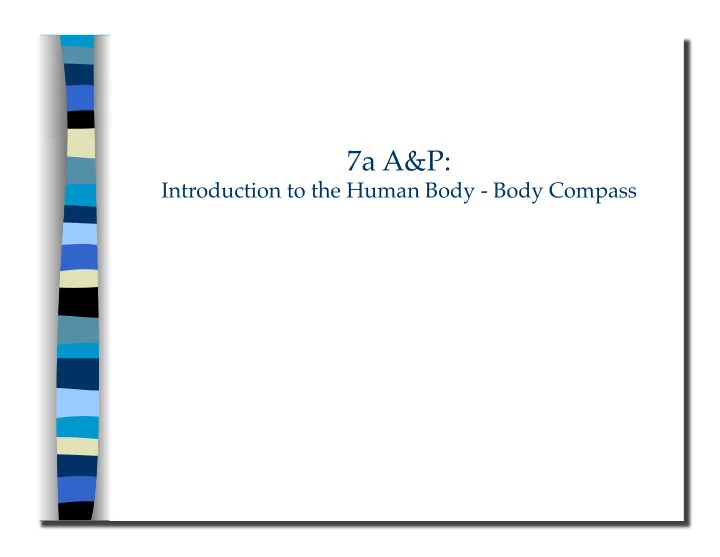

7a A&P: Introduction to the Human Body - Body Compass
7a A&P: Introduction to the Human Body - Body Compass � Class Outline � 5 minutes � � Attendance, Breath of Arrival, and Reminders � 10 minutes � Lecture: AOIs of the gluteals � 5 minutes � � Active study skills for AOIs of new muscles � 25 minutes � Lecture: � 15 minutes � Active study skills: � 60 minutes � Total �
7a A&P: Introduction to the Human Body - Body Compass � Class Reminders �
Classroom Rules � Punctuality - everybody’s time is precious � Be ready to learn at the start of class; we’ll have you out of here on time � � Tardiness: arriving late, returning late after breaks, leaving during class, leaving � early � The following are not allowed: � Bare feet � � Side talking � � Lying down � � Inappropriate clothing � � Food or drink except water � � Phones that are visible in the classroom, bathrooms, or internship � � You will receive one verbal warning, then you’ll have to leave the room. �
Gastrocnemius and Soleus � Trail Guide, Page 371 � Gastrocnemius and soleus form the large mass of posterior leg muscle. Together they are known as the triceps surae . � The superficial gastrocnemius has two heads and crosses two joints - the knee and ankle. � Soleus is deep to the gastrocnemius, yet its medial and lateral fibers bulge from the sides of the leg, � When do you use your triceps surae? � Posterior View �
Actions of the Triceps Surae � Gastrocnemius and Soleus � Plantarflexion of the talocrucral joint Flexion of the tibiofemoral joint
A � O � � Posterior View I �
A � O � � Posterior View I �
A � O � I � � Posterior View
A � O � I � � Posterior View
A � O � � Posterior View I �
A � O � I � � Posterior View
A � O � I � � Posterior View
7a A&P: Introduction to the Human Body - Body Compass � E-11
Homeostasis Homeostasis Constancy of the body's internal environment. It represents � a relatively stable condition within a very limited range. � Example: when we get too cold our muscles spasm (shivering) to warm us. �
Membranes � Membrane Soft pliable sheets of tissue that cover the body, line tubes or � body cavities, cover organs, and separate one part of a cavity from another. �
Membranes � Cutaneous membrane (AKA: skin) Epithelial membrane that covers the entire surface of the body . �
Membranes � Mucous membrane (AKA: mucosa) Epithelial membrane that lines openings to the outside of the body. Example: nasal membrane. �
Membranes � Serous membrane Epithelial membrane that lines closed body cavities that do not open to the outside of the body. � Example: � pericardium. �
Membranes � Synovial membrane Connective tissue membrane that lines cavities of � freely moving joints. �
Fill in the Blanks 1. membrane = covers the external body surface. � 2. membrane = lines openings to the outside of the body � 3. membrane = lines body cavities. � 4. membrane = freely moving joints. �
Fill in the Blanks 1. Cutaneous membrane = covers the external body surface. � 2. Mucous membrane = lines openings to the outside of the body � 3. Serous membrane = lines body cavities. � 4. Synovial membrane = freely moving joints. �
Anatomic Position Anatomic position Standard body position used in Western medicine. The � body is upright and facing forward, arms at the sides, palms facing forward , thumbs to the side, feet are about hip distance apart, with toes pointing forward. �
Planes of References Plane A flat surface determined by three points in space such as height, depth, and width. �
Planes of References Midsagittal (AKA: median plane) Plane that runs longitudinally or vertically down the body, anterior to posterior, dividing the body into equal right , and left sections. �
Planes of References Sagittal plane Plane that passes through the body parallel to the � � midsagittal plane. �
Planes of References Frontal (AKA: coronal plane) Plane that passes through the body side to side, creating anterior and posterior sections. �
Planes of References Transverse (AKA: horizontal plane) Plane that passes through the body to create superior and inferior sections. �
Directional Terms Superior (AKA: cranial or cephalic) Situated above or toward the head end. � Inferior (AKA: caudal) Situated below or towards the tail end. �
Directional Terms Anterior (AKA: ventral) Pertaining to the front side of a structure. � Posterior (AKA: dorsal) Pertaining to the back of a structure. �
Directional Terms Medial Oriented toward or near the midline of the body. � Lateral Oriented farther away from the midline of the body. �
Directional Terms Ipsilateral (AKA: homolateral) Related to the same side of the body. � Contralateral Related to opposite sides of the body. �
Directional Terms Proximal Nearer to the point of reference. Extremities only. � Distal Farther from the point of reference. Extremities only. �
Directional Terms Deep (AKA: central) Pertaining to or situated at the center of the body. � Superficial (AKA: peripheral) Pertaining to the outside surface, � periphery, or surrounding the external area of a structure. �
Response Moment
7a A&P: Introduction to the Human Body - Body Compass
Recommend
More recommend